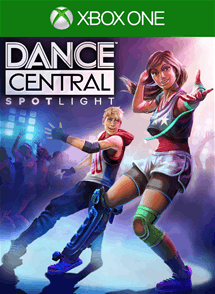Dance Central Spotlight
| Dance Central Spotlight | |
|---|---|
 | |
| Developer(s) | Harmonix |
| Publisher(s) | Microsoft Game Studios |
| Series | Dance Central |
| Platform(s) | Xbox One |
| Release | September 2, 2014 |
| Genre(s) | Music, rhythm |
| Mode(s) | Single-player, multiplayer |
Dance Central Spotlight is a music rhythm game developed by Harmonix and published by Microsoft Game Studios for the Xbox One Kinect.
The game provides a stripped-down experience in comparison to previous Dance Central titles, maintaining the core gameplay of the franchise, but with a focus on providing more routines per-song, the regular release of new, recent songs as downloadable content, and leverage of improvements to the motion detection capabilities of Kinect for Xbox One.
Gameplay
Similarly to previous installments in the franchise, players must mirror the dance routine of an on-screen dancer, as instructed by "flash cards" indicating specific moves in the routine. Players are judged and scored on the accuracy of their performance.[1] Each song includes up to eight routines, including four difficulty levels of the standard routine, along with two fitness-oriented routines and two "alternate" routines. Additional routines and difficulty levels are unlocked for songs by collecting "Flawless" ratings on individual moves.[1]
Spotlight focuses primarily on the core gameplay of the franchise, with a simplified offering of standard and fitness modes, and no story mode or other minigames like past versions. The practice mode was overhauled to use a dynamic, "on-demand" approach, rather than the "regimented" approach used by previous Dance Central games: players can now jump to training mode in-game by using a voice or controller command. Once activated, the player can practice the relevant portion, slow down the routine, and go to different parts of the song. When the player exits practice, the song continues from where it was left off.[1][2]
Development and release
Dance Central Spotlight was unveiled at E3 2014.[3] The overall gameplay of the Dance Central franchise was enhanced by the increased capabilities of the Xbox One Kinect sensor, which has a higher resolution camera and better gesture recognition than the Xbox 360 iteration. In total, the game can recognize 7,000 different dance moves.[3][4] Harmonix director Matthew Nordhaus also teased the presence of tougher alternate routines for individual songs, aimed particularly at expert players.[4] Harmonix co-founder Alex Rigopulos felt that Microsoft's introduction of lower-cost Xbox One bundles excluding Kinect wasn't a "shock" and the bundling of Kinect with Xbox One on launch did not influence the development of Spotlight in any way.[3]
Unlike previous installments in the franchise, Spotlight places a heavy emphasis on downloadable content and the ability for players to purchase songs on an À la carte basis; Nordhaus noted that due to improvements in motion capture technology and the need to perform fewer QA tests because of the improved Kinect accuracy (specifically noting the need to do large levels of tuning for hand detection on the Xbox 360 version), Harmonix staff could produce new routines for the game in just "days" rather than months. Emphasizing that players wanted to have quicker in-game access to current hit music, Nordhaus stated that Harmonix would now be able to release new songs as DLC while they are still charting.[3][4]
Dance Central Spotlight was officially released on September 2, 2014; unlike other installments in the series, the game is only available via digital means. The base game includes 10 songs; new songs for the game were released on a near-weekly basis for a "substantial" period of time.[3][4][5] A pre-paid code to download Spotlight is also included with standalone Kinect for Xbox One units, which were released in October 7, 2014.[6]
On March 8, 2015, Nisha and Claptrap (despite his lack of legs) from the Borderlands franchise were added as bonus characters via cheat codes; Harmonix had assisted in animating portions of a trailer for Borderlands: The Pre-Sequel! (which was being re-released for Xbox One later that month alongside a port of Borderlands 2).[7][8]
Legacy downloadable content
All DLC from previous Dance Central games were ported to Spotlight—they were re-released progressively in batches following the game's release. The ported DLC include their standard routines from the original version, along with four alternate routines, as with Spotlight-specific songs. Songs that were previously purchased on the Xbox 360 versions of Dance Central can be re-downloaded on Spotlight at no extra charge.[3][4][5][9][10]
Reception
GameSpot gave Spotlight an 8 out of 10, praising its cleaner interface and dropping of extraneous features for "[removing] the obstacles between you and just getting out there and dancing", and its new business model as a "tremendous value" for players. However, its minimalistic feedback for player performance was considered a double-edged sword due to the new unlock system's emphasis on rewarding the learning of individual moves.[1]
References
- 1 2 3 4 "Dance Central Spotlight review: Twerking hard or hardly twerking?". GameSpot. Retrieved 26 November 2014.
- ↑ "Practice Makes Perfect in Dance Central Spotlight". Microsoft. Retrieved 26 November 2014.
- 1 2 3 4 5 6 "Harmonix is back to selling Kinect sensors with Dance Central: Spotlight". Polygon. Retrieved 26 November 2014.
- 1 2 3 4 5 "Harmonix shines the Dance Central Spotlight on the Xbox One (interview)". VentureBeat. Retrieved 28 August 2014.
- 1 2 "Dance Central Spotlight dated, will cost $10". CVG. Future plc. Retrieved 28 August 2014.
- ↑ "Standalone Xbox One Kinect Launching October 7 for $150 With Dance Central". GameSpot. Retrieved 16 December 2014.
- ↑ Sirani, Jordan (March 18, 2015). "Borderlands: The Handsome Collection Gone Gold". IGN. Retrieved March 19, 2015.
- ↑ "Borderlands' Nisha And Claptrap Available Now As Free Dance Central: Spotlight Dancers". Game Informer. Retrieved 8 March 2015.
- ↑ "Dance Central Songs". Microsoft. Retrieved 26 November 2014.
- ↑ "New Dance Central DLC: Two Great Legacy Packs!". Microsoft. Retrieved 26 November 2014.